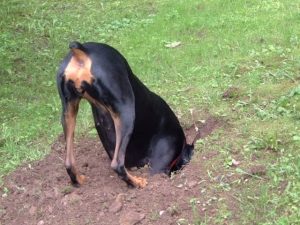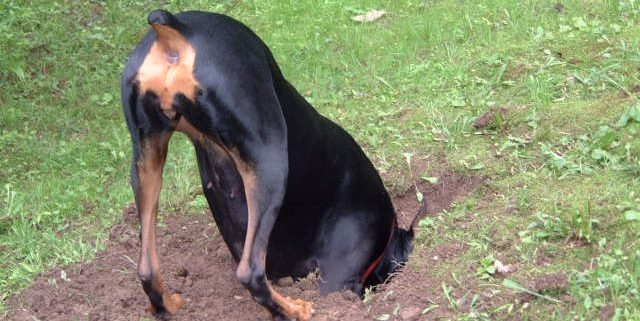Ask Crystal: Not Digging a Digging Dog
Welcome to “Ask Crystal,” where you can ask your pet behavior questions! You can submit your question for Crystal at the bottom of the page!
Dear Crystal,
I am getting ready to do some landscaping in my back yard this summer. I am a bit worried about spending a lot of money on plants because my dog is quite the digger. I find holes all over my back yard. How can I train him to stop digging before he ruins all of my hard work?
Sincerely,
Don’t Dig Dog
Dear Don’t,
 When we approach problem behaviors in our dogs that are about something that we don’t want them to do, we need to take a management approach rather than a training approach. Training is more about a specific behavior that we want the dog to do. Also, when behaviors occur while we are not present, it is rather difficult to correct them. Digging is a natural, instinctual behavior which can make it even harder to curb. However, if we can get down to the root of why the dog is digging, we may be able to redirect their behavior to something that is more desirable than making our backyard look like the surface of the moon. You don’t mention the location of the holes but that is a very important detail to know. Depending on where the holes are located, we may be able to determine the motivation for the digging.
When we approach problem behaviors in our dogs that are about something that we don’t want them to do, we need to take a management approach rather than a training approach. Training is more about a specific behavior that we want the dog to do. Also, when behaviors occur while we are not present, it is rather difficult to correct them. Digging is a natural, instinctual behavior which can make it even harder to curb. However, if we can get down to the root of why the dog is digging, we may be able to redirect their behavior to something that is more desirable than making our backyard look like the surface of the moon. You don’t mention the location of the holes but that is a very important detail to know. Depending on where the holes are located, we may be able to determine the motivation for the digging.
If you have holes located along your fence line that may indicate a dog that is trying to pull an Alcatraz escape. Why would your dog want to escape your home where he gets 2 squares? If your dog has gotten out in the past and had a grand ole adventure, he is probably trying to recreate those glory days. It is very important to prevent our dogs from ever learning the joy of that particular adventure as it is very reinforcing and a very difficult habit to stop. If you have a very anxious dog, he may be trying to get out so that he can be reunited with you. A practical fix might be to bury chicken wire either 1-2 feet deep or a L-fencing along the bottom of the fence to prevent digging out.
I would also suggest that you look at the amount of exercise you are giving your dog as well. If you have a young energetic dog or a very socially motivated dog, they may be digging out of boredom or loneliness. These holes could be along the fence or anywhere that has good digging soil. Maybe the pretty poodle next door is calling his name. Dogs are very social creatures and need the company of people and/or other animals. Most people don’t realize that leaving your dog in the back yard is not a form of exercise. Dogs don’t exercise themselves. They need interactive play to burn energy. That means activities where you do things with them like walks, hikes, swimming, fetch, tug or flirt pole time. If you don’t know what a flirt pole is, it is basically a cat teaser for a dog and it burns a lot of energy. I use it to teach self-control to dogs while playing. You can make one very cheaply from PVC pipe and an old toy. If your dog is dog friendly, consider doggie day care once or twice a week to keep up on his social skills and burn energy. Daily training sessions are also a great way to burn energy and bond with your dog. Feeding him from food enrichment toys will also help to burn some of that excess energy. I would suggest tossing treats or kibble all over the yard for him to hunt. My dogs love kibble hunting and will spend hours wondering around the backyard sniffing.
If you notice the digging happens in the summer and then see your dog lying in said hole, it may be an attempt to cool down. The soil underneath is much cooler than the top layer and is something a dog in the wild would do before sleeping. The cool soil in a freshly laid garden is especially attractive to lie in. If this seems to be the motivation, I would suggest building a digging pit. Measure your dog’s stretched out length so you can build a pit long enough for him to stretch out in. You can build a rectangular pit with inexpensive boards and then fill it with playground sand. Wetting the sand daily also makes it cooler and more attractive to lie in. If you have neighborhood cats, you may want to cover it so that it doesn’t become a litterbox. If you have a smaller dog, you may be able to use a child’s sandbox that has a cover already. A digging pit is a great outlet for your digging dog if they just really seem to enjoy digging. Try burying favorite toys in the sand to encourage him to dig and give him something fun to do. You are going to want to make it easy at first by having the toy sticking out of the sand a bit. After he starts to get the hang of it try burying it deeper and deeper. You can bury biscuits and other treats as well to encourage digging in the right spot. If that isn’t an option, can you hang a tarp in the trees or otherwise think of some way to create a shady spot?
If you notice that the digging seems to occur in the same spot or in straight lines in the yard, you may have a critter in ground. I will often see my dog stare and then sniff excitedly at the ground and then begin to dig. The best bet in these situations is to try to figure out how to get rid of the critters in a nontoxic manner. An underground barrier can help keep pests out and keep your dog from digging out as well. Two birds with one stone as they say.
Spending time in the garden is one of the great joys of owning a dog in my opinion. In these long summer days enjoy the companionship of your canine friend and get outside!
Until next time,
Crystal







